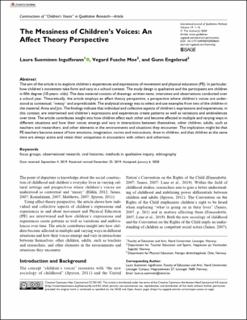The Messiness of Children’s Voices: An Affect Theory Perspective
Peer reviewed, Journal article
Published version

View/
Date
2020Metadata
Show full item recordCollections
Original version
Ingulfsvann, L. S., Moe, V. F., & Engelsrud, G. (2020). The messiness of children’s voices: An affect theory perspective. International Journal of Qualitative Methods, 19. 10.1177/1609406920958601Abstract
The aim of the article is to explore children’s experiences and expressions of movement and physical education (PE). In particular, how children’s movement take form and vary in a school context. The study design is qualitative and the participants are children in fifth degree (10-years- olds). The data material consists of drawings, written texts, interviews and observations conducted over a school year. Theoretically, the article employs an affect theory perspective, a perspective where children’s voices are understood as contextual, “messy” and unpredictable. The analytical strategy was to select and use examples from two of the children in the material; Anna and Jon. The findings indicate that individual and collective aspects of children’s expressions and experiences, in this context, are intertwined and children’s expressions and experiences create patterns as well as variations and ambivalences over time. The article contributes insight into how children affect each other and become affected in multiple and varying ways in different situations and how their voices emerge and vary in interactions between themselves, other children, adults, such as teachers and researchers, and other elements in the environments and situations they encounter. The implication might be that PE teachers become aware of how emotions, imagination, norms and instructions, draw in children, and that children at the same time are always active and retain their uniqueness in encounters with others and otherness.
